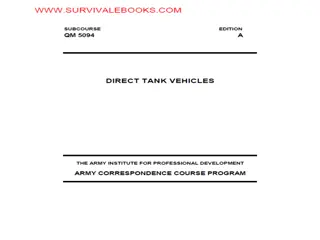Update on Categorization of Automated Vehicles by OICA and CLEPA
OICA and CLEPA are updating the categorization of automated vehicles, introducing new subcategories and refining definitions for driverless and dual-mode vehicles. The work aligns with ongoing efforts in related groups and aims to enhance clarity in classifying different types of automated vehicles under Consolidated Resolution R.E.3.
Download Presentation

Please find below an Image/Link to download the presentation.
The content on the website is provided AS IS for your information and personal use only. It may not be sold, licensed, or shared on other websites without obtaining consent from the author. Download presentation by click this link. If you encounter any issues during the download, it is possible that the publisher has removed the file from their server.
E N D
Presentation Transcript
Submitted by the experts from CLEPA and OICA Informal document GRSG-126-39 126th GRVA, 10-13 October 2023 Provisional agenda item 14 Informal document GRVA-17-37 17th GRVA, 25-29 Sept 2023 Provisional agenda item 4(e)(ii) Considerations on the categorization of Automated Vehicles - Update -
Status of work OICA/CLEPA have worked furter on the categorization of automated vehicles, assessing the S.R. 1 vehicle categories, similar to the R.E. 3 proposed amendments Additionally, the wording of the definitions for dual-mode vehciles and driverless vehicles was refined, considering the feedback received during GRVA-16 and in order to further align with the work ongoing in FRAV, VMAD and the Integration Group
Vehicle categorization under R.E.3 New sub categories for Automated Vehicles (AV s) Subcategory A Driverless Vehicles with ADS Subcategory D Dual Mode vehicles Subcategories X & Y Low speed driverless AV s Designed primarily for the carriage of people Designed primarily for the carriage of goods Designed primarily for the carriage of people Designed primarily for the carriage of goods With or w/o passengers Examples: Examples: N1A N1 M1A M1 M1D M2X Driver seat + max. 8 add. seats, no limitation of GVM seated only, max. 9 seats GVM </= 3.5t GVM </= 3.5t e.g. Robotaxi < [25] km/h e.g. Campus shuttle N2 N2A M2A M2 N3D Driver seat + more than 8 add. seats, GVM max. 5 t More than 9 seats or standing passengers, GVM Max. 5t 3.5t < GVM </= 12t 3.5t < GVM </= 12t M2Y e.g. Hub-2-Hub truck N3 M3 M3A [25] km/h </= v </= [50] e.g. Urban shuttle M1Z N3A Driver seat + more than 8 add. seats, GVM exceeding 5 t GVM > 12t More than 9 seats or standing passengers, GVM exceeding. 5t GVM > 12t e.g. AVP equipped vehicle *Class I, II, III and Class A, B can be carried over Vehicles which can be driven manually under nominal conditions AV s which do not require a driver/fallback-ready user
Categories according to Consolidated Resolution R.E.3 Required amendments to existing Definitions: 2.2. 2.2.1. Category M - Power-driven vehicles having at least four wheels and used for the carriage of passengers "Category M1": Vehicles used for the carriage of passengers and comprising not more than eight nine seats in addition to the driver's seat. "Category M2": Vehicles used for the carriage of passengers, comprising more than eight nine seats in addition to the driver's seat or designed to carry standing passengers, and having a maximum mass not exceeding 5 tonnes. "Category M3": Vehicles used for the carriage of passengers, comprising more than eight nine seats in addition to the driver's seat or designed to carry standing passengers, and having a maximum mass exceeding 5 tonnes. Vehicles of categories M2 and M3 belong to: For vehicles having a capacity exceeding [23] occupants 22 passengers in addition to the driver, there are three classes of vehicles: 2.2.4.1.1. "Class I": Vehicles constructed with areas for standing passengers, to allow frequent passenger movement. 2.2.4.1.2. "Class II": Vehicles constructed principally for the carriage of seated passengers, and designed to allow the carriage of standing passengers in the gangway and/or in an area which does not exceed the space provided for two double seats. 2.2.4.1.3. "Class III": Vehicles constructed exclusively for the carriage of seated passengers. 2.2.4.1.4. A vehicle may be regarded as belonging in more than one class. In such a case it may be approved for each class to which it corresponds. 2.2.4.2. For vehicles having a capacity not exceeding [23] occupants 22 passengers in addition to the driver, there are two classes of vehicles: 2.2.4.2.1. "Class A": Vehicles designed to carry standing passengers; a vehicle of this class has seats and shall have provisions for standing passengers. 2.2.4.2.2. "Class B": Vehicles not designed to carry standing passengers; a vehicle of this class has no provision for standing passengers. 2.2.2. 2.2.3. 2.2.4. 2.2.4.1.
Categories according to Consolidated Resolution R.E.3 New categories: New Dual-mode sub category: 2.x. Dual-mode vehicles with Automated Driving Systems 2.x.1. Definition. Dual-mode vehicles are vehicles of category M or N which can be driven manually and which are equipped with an Automated Driving System allowing the vehicle to be driven in an automated mode not issuing a [system initiated deactivation to manual driving] requiring an interaction by a driver to take back manual control (e.g. a fallback user). 2.x.2 Categorization Dual-mode vehicles are categorized into two categories, based on the maximum operational design speed of the Automated Driving System. In cases were the Automated Driving System consists of multiple features, e.g. low-speed and high-speed ADS features, the feature with the highest maximum design speed is defining the maximum design speed of the Automated Driving System and therefore considered for the dual-mode categorization. Category D are dual mode vehicles having a maximum operational speed of the Automated Driving System exceeding [25] km/h. Category Z are dual mode vehicles having a maximum operational speed of the Automated Driving System not exceeding [25] km/h. 2.x.2.1. 2.x.2.2. 2.x.3. Combined designation Symbols M and N may be combined with symbol D or Z. For example, a vehicle of category M1 which is suited for dual-mode use having a maximum operational speed of the Automated Driving System exceeding [25] km/h may be designated as M1D.
Categories according to Consolidated Resolution R.E.3 New categories (continued): New Driverless Vehicles sub category: 2.y. Category A Driverless vehicles with Automated Driving Systems 2.y.1. Definition. Driverless vehicles are vehicles of category M or N which are equipped with an Automated Driving System which by design prevents the vehicle to be driven manually except for specific purposes outside nominal operation (e.g. maintenance, remote intervention, ). 2.y.2. Combined designation Symbols M and N may be combined with symbol A. For example, a vehicle of category M1 which is considered an driverless vehicle shall be designated as M1A. New Low speed driverless vehicles sub categories: 2.z. Low-speed driverless vehicles with Automated Driving Systems 2.z.1. Definition 2.z.1.1. Category X are vehicles belonging to category A, but having a maximum design speed not exceeding [25] km/h. 2.z.1.2. Category Y are vehicles belonging to category A, having a maximum design speed exceeding [25] km/h but not exceeding [50] km/h 2.z.2. Combined designation Symbols M and N may be combined with symbol X or Y. For example, a vehicle of category M1 which is considered a low-speed driverless vehicle of Category Y shall be designated as M1Y.
Vehicle categorization under S.R.1 New sub categories for Automated Vehicles (AV s) Subcategory A Driverless Vehicles with ADS Subcategory D Dual Mode vehicles Subcategories X & Y Low speed driverless AV s Designed primarily for the carriage of people Designed primarily for the carriage of goods Designed primarily for the carriage of people Designed primarily for the carriage of goods With or w/o passengers Examples: Examples: 2A 2 1-1A 1-1 1-1D 1-2X Driver seat + max. 8 add. seats, only seated passengers seated only, max. 9 seating positions e.g. Robotaxi < [25] km/h e.g. Campus shuttle 2A 2 1-2 2D 1-2A 1-2Y e.g. Hub-2-Hub truck 1-2 1-2A 2 [25] km/h </= v </= [50] e.g. Urban shuttle 1-1Z 2A Driver seat + more than 8 add. Seats, seated and/or standing passengers More than 9 passengers (standing and/or seated) e.g. AVP equipped vehicle Vehicles which can be driven manually under nominal conditions AV s which do not require a driver/fallback-ready user
Categories according to Special Resolution S.R.1 Required amendments to existing Definitions: 1. POWER DRIVEN VEHICLES WITH FOUR OR MORE WHEELS 1.1. "Category 1 vehicle" means a power driven vehicle with four or more wheels designed and constructed primarily for the carriage of (a) person(s). 1.1.1. "Category 1-1 vehicle" means a category 1 vehicle comprising not more than eight nine seating positions in addition to the driver s seating position. A category 1-1 vehicle cannot have standing passengers. 1.1.2. "Category 1-2 vehicle" means a category 1 vehicle designed for the carriage of more than eight nine passengers, whether seated or standing, in addition to the driver. 1.2. "Category 2 vehicle" means a power driven vehicle with four or more wheels designed and constructed primarily for the carriage of goods. This category shall also include: i) tractive units ii) chassis designed specifically to be equipped with special equipment.
Categories according to Consolidated Resolution S.R.1 New categories: New Dual-mode sub category: 2.x. Dual-mode vehicles with Automated Driving Systems 2.x.1. Definition. Dual-mode vehicles are vehicles of category M or N which can be driven manually and which are equipped with an Automated Driving System allowing the vehicle to be driven in an automated mode not issuing a [system initiated deactivation to manual driving] requiring an interaction by a driver to take back manual control (e.g. a fallback user). 2.x.2 Categorization Dual-mode vehicles are categorized into two categories, based on the maximum operational design speed of the Automated Driving System. In cases were the Automated Driving System consists of multiple features, e.g. low-speed and high-speed ADS features, the feature with the highest maximum design speed is defining the maximum design speed of the Automated Driving System and therefore considered for the dual-mode categorization. 2.x.2.1. Category D are dual mode vehicles having a maximum operational speed of the Automated Driving System exceeding [25] km/h. 2.x.2.2. Category Z are dual mode vehicles having a maximum operational speed of the Automated Driving System not exceeding [25] km/h. 2.x.3. Combined designation Symbols 1-1, 1-2 and 2 may be combined with symbol D or Z. For example, a vehicle of category 1-1 which is suited for dual-mode use having a maximum operational speed of the Automated Driving System exceeding [25] km/h may be designated as 1-1D.
Categories according to Consolidated Resolution S.R.1 New categories: New Driverless Vehicles sub category: 2.y. Category A Driverless vehicles with Automated Driving Systems 2.y.1. Definition. Driverless vehicles are vehicles of category M or N which are equipped with an Automated Driving System which by design prevents the vehicle to be driven manually except for specific purposes outside nominal operation (e.g. maintenance, remote intervention, ). 2.y.2. Combined designation Symbols 1-1, 1-2 and 2 may be combined with symbol A. For example, a vehicle of category 1-1 which is considered an driverless vehicle shall be designated as 1-1A. New Low speed driverless vehicles sub categories: 2.z. Low-speed driverless vehicles with Automated Driving Systems 2.z.1. Definition 2.z.1.1. Category X are vehicles belonging to category A, but having a maximum design speed not exceeding [25] km/h. 2.z.1.2. Category Y are vehicles belonging to category A, having a maximum design speed exceeding [25] km/h but not exceeding [50] km/h 2.z.2. Combined designation Symbols M and N may be combined with symbol X or Y. For example, a vehicle of category M1 which is considered a low-speed driverless vehicle of Category Y shall be designated as M1Y.
Proposal for next steps OICA/CLEPA wishes to renew their wish to have a joint Workshop established on the topic of Categorization of Automated Vehicles between GRVA and GRSG in order to have experts in the field on Automated/Autonomous Vehicles and Vehicle Categorization collectively working together on the subject. OICA/CLEPA is planning to introduce this concept also at the upcoming session of GRSG-126 in October 2023


























